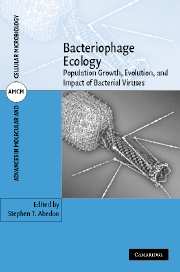Book contents
- Frontmatter
- Contents
- About the cover
- List of contributors
- Foreword by Bruce R. Levin
- Preface
- 1 Phages, ecology, evolution
- Part I Phage ecology
- Part II Phage evolutionary biology
- Part III Phage ecology in environments
- 10 Aquatic phage ecology
- 11 Phage ecology of terrestrial environments
- 12 Phages, bacteria, and food
- 13 Interaction of bacteriophages with animals
- 14 Phage ecology of bacterial pathogenesis
- Part IV Modeling phage ecology
- Index
- Plate section
12 - Phages, bacteria, and food
from Part III - Phage ecology in environments
Published online by Cambridge University Press: 29 September 2009
- Frontmatter
- Contents
- About the cover
- List of contributors
- Foreword by Bruce R. Levin
- Preface
- 1 Phages, ecology, evolution
- Part I Phage ecology
- Part II Phage evolutionary biology
- Part III Phage ecology in environments
- 10 Aquatic phage ecology
- 11 Phage ecology of terrestrial environments
- 12 Phages, bacteria, and food
- 13 Interaction of bacteriophages with animals
- 14 Phage ecology of bacterial pathogenesis
- Part IV Modeling phage ecology
- Index
- Plate section
Summary
INTRODUCTION
Bacteriophages have been observed to occupy virtually every ecological niche, and it should be no surprise that they are naturally present in food. While most phage—host interactions in food are inferred, but not routinely or knowingly observed, the phage-mediated destruction of starter cultures during fermentation of dairy products is a potent reminder of the ability of bacterial viruses to alter the microbial ecology of food. Alternatively, in recent years researchers have developed applied uses of bacteriophages, especially to solve agricultural problems. For example, bacteriophages have been proposed as indicators of possible viral and fecal contamination of food, while the ability of lytic bacteriophages to infect and kill their hosts has been exploited in the biocontrol of foodborne pathogenic and spoilage bacteria. Other workers have developed phage-based methods to rapidly detect bacterial pathogens. Most of these methods take advantage of the ability of phages to amplify themselves to large numbers during bacterial infection. Nevertheless, it is clear that several challenges must be overcome before phages will be routinely used as components of food production. These include the problem of bacterial resistance to phage infection and the need for separation of target bacteria from the food matrix during phage-mediated bacterial detection.
- Type
- Chapter
- Information
- Bacteriophage EcologyPopulation Growth, Evolution, and Impact of Bacterial Viruses, pp. 302 - 331Publisher: Cambridge University PressPrint publication year: 2008
- 6
- Cited by



